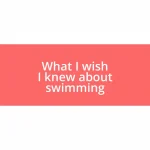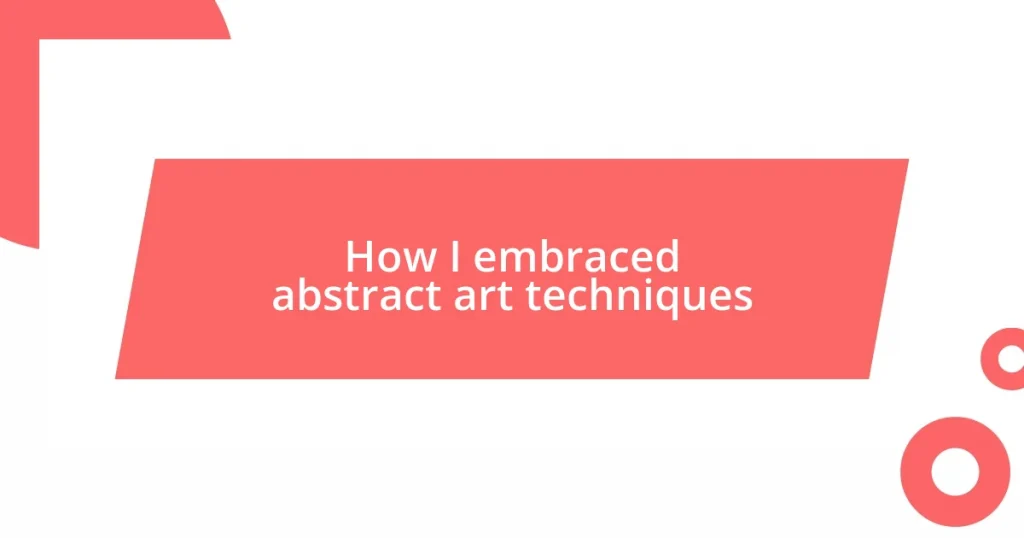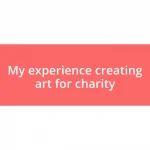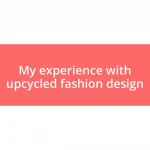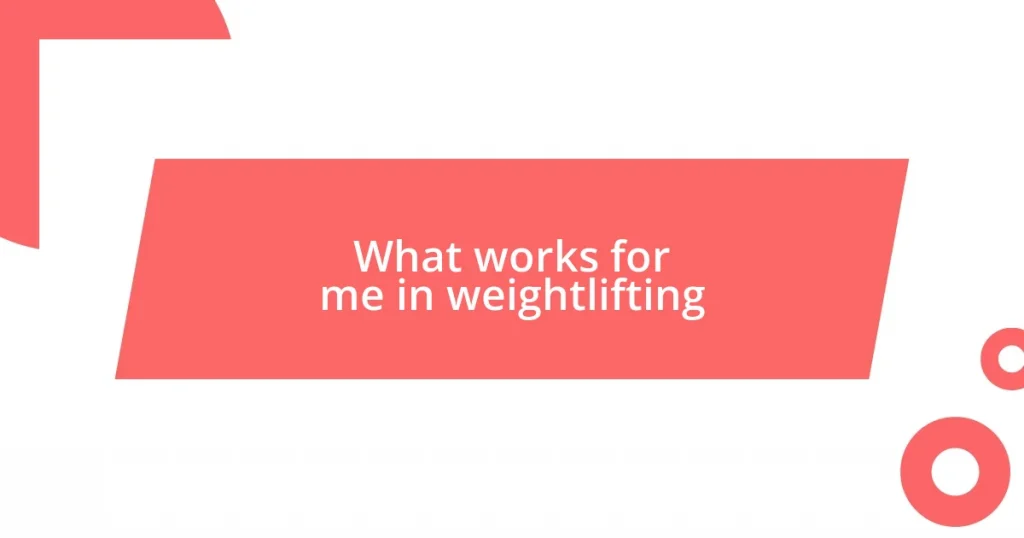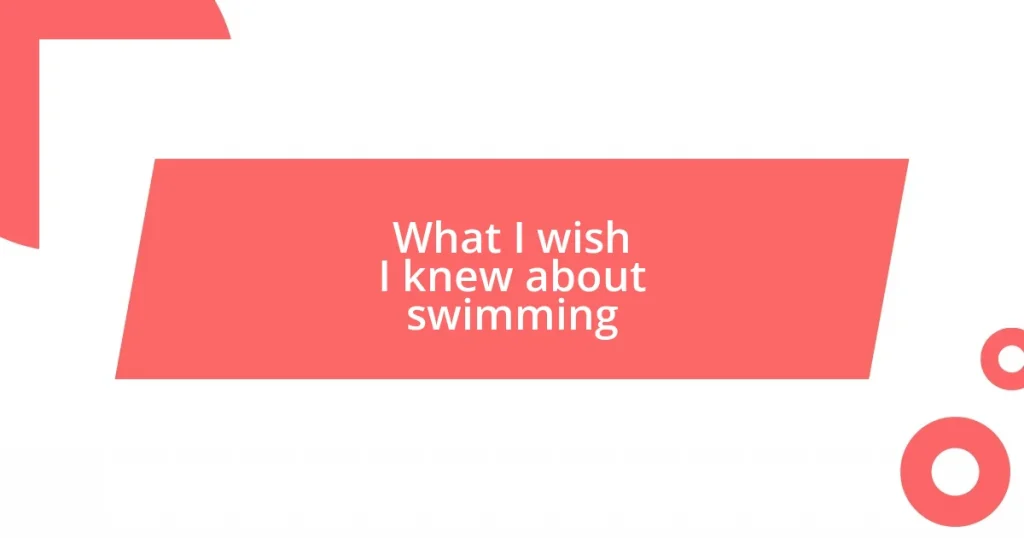Key takeaways:
- Abstract art allows for emotional expression through non-representational forms, colors, and techniques, inviting viewers to explore deeper meanings.
- Experimenting with different styles and materials, such as gestural abstraction and mixed media, fosters personal storytelling and enhances creative exploration.
- Effective showcasing techniques, like thoughtful presentation and engaging social media, can significantly elevate the viewer’s experience and foster community connection around art.
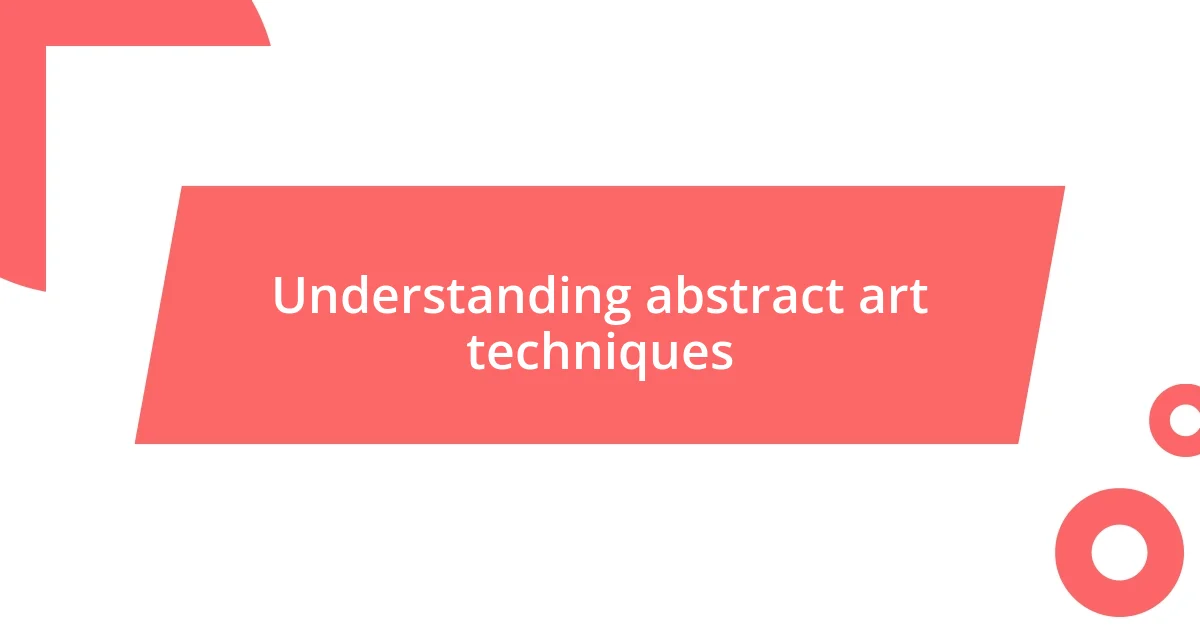
Understanding abstract art techniques
Abstract art techniques can often feel elusive, yet they invite us to delve into our emotions and perceptions. I remember the first time I stood in front of a canvas splattered with vibrant colors and chaotic shapes—I was struck by a wave of confusion and wonder. What was this piece trying to convey? That moment sparked my journey to understand how abstraction allows artists to express feelings and concepts that words often can’t capture.
One key aspect of abstract art is the use of non-representational forms and colors. In my experience, working with bold strokes and unexpected hues opened up a dialogue between my inner self and the canvas. I often found myself pondering how certain colors could evoke joy while others stirred a sense of melancholy—it’s fascinating how our emotional responses can shape our interpretation.
I often ask myself, how does one decide when an artwork is “finished”? This question haunted me during my early experiments, where I’d constantly add and subtract elements. Over time, I learned that sometimes the beauty lies in spontaneity—the unapologetic embrace of imperfection. Techniques like dripping, pouring, or layering paint can lead to surprising outcomes that breathe life into the work, offering both the artist and viewer a new perspective to explore.
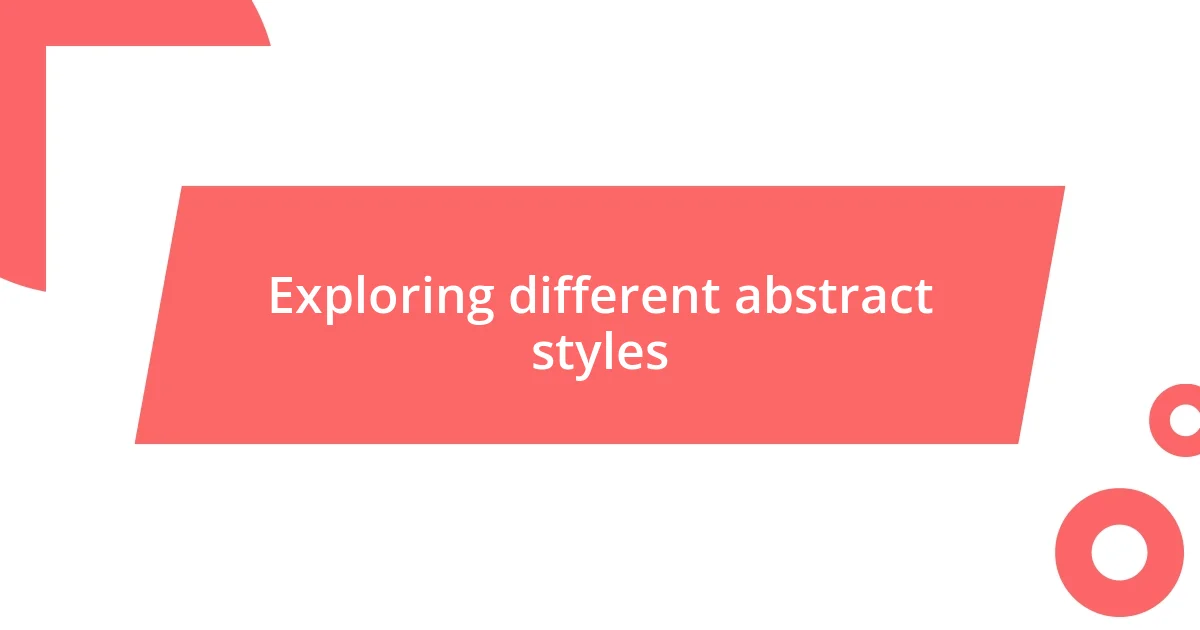
Exploring different abstract styles
Exploring different abstract styles opens up a world of creative possibilities. One of my favorite styles is gestural abstraction, where the physical act of painting becomes a central focus. I recall a day spent in my studio, fervently applying paint with my hands, feeling the texture beneath my fingertips. This tactile experience not only liberated my expression but also deepened my emotional connection to the artwork. Each stroke became a release of bottled emotions, allowing me to narrate a personal story without uttering a single word.
Another intriguing style is color field painting, which emphasizes vast expanses of solid color. I remember creating a piece primarily composed of soft blues and greens, aiming to evoke a sense of tranquility. Standing back to observe the finished canvas, I felt an overwhelming wave of calm wash over me. It was a striking reminder of how colors can transport us to different emotional landscapes, leaving an indelible mark on our psyche. Every artist has a unique perspective on color, and I find it truly compelling how this technique can shift the viewer’s mood so powerfully.
Lastly, I’ve dabbled in collage techniques, merging various materials and textures to form cohesive abstractions. One afternoon, I gathered scraps from my old sketches and magazines, weaving them together on a canvas. The process felt like a conversation—each piece vying for attention and harmonizing in a delightful chaos. The vibrancy from the mixture of media reflected my own journey, showcasing the beauty found in diversity. Such explorations make abstract art a continually evolving narrative, worthy of our time and reflection.
| Abstract Style | Description |
|---|---|
| Gestural Abstraction | Focuses on the artist’s physical movement and emotional expression through paint application. |
| Color Field Painting | Emphasizes large areas of color to evoke mood and atmospheric qualities. |
| Collage Techniques | Involves combining various materials to create texture and depth within abstract forms. |
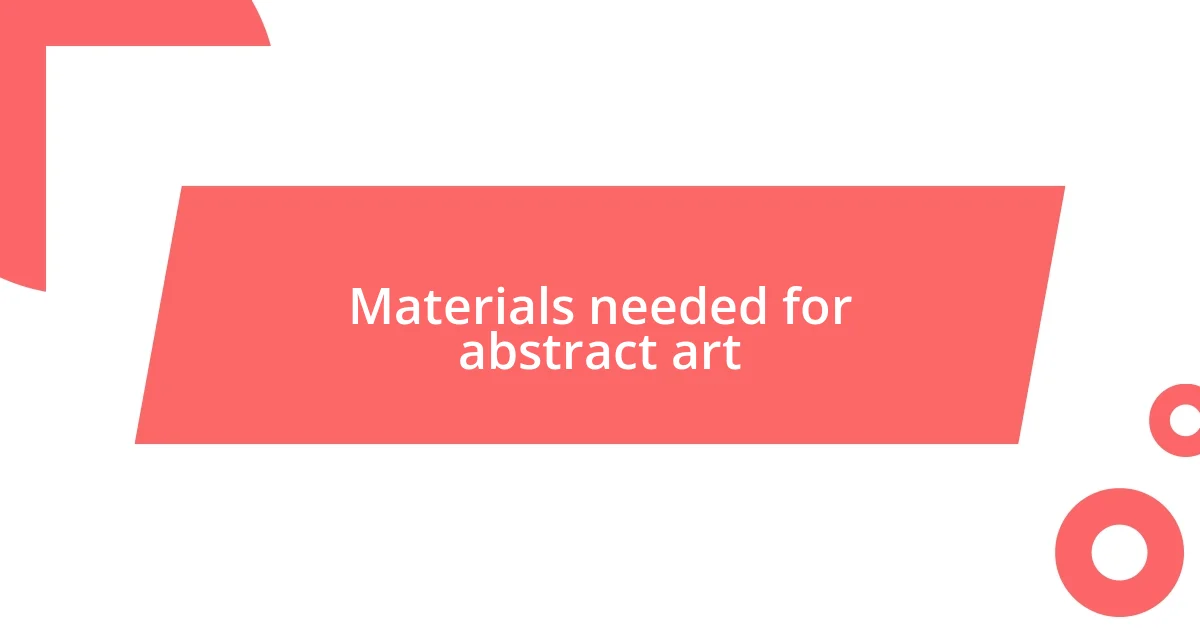
Materials needed for abstract art
When diving into abstract art, it’s crucial to gather the right materials to unleash your creativity. I still vividly recall my first trip to the art supply store, overwhelmed by the sheer variety of options. I started with basic supplies, but soon learned that experimenting with different tools can greatly influence the outcome of your work. Here’s what I found to be essential for any abstract artist:
- Canvas or Paper: A sturdy surface is key for your creativity to flourish.
- Acrylic or Oil Paints: These vibrant mediums offer fluidity and depth, allowing for endless combinations.
- Brushes of Various Sizes: Different shapes and sizes can create diverse expressive marks and textures.
- Palette Knives: Perfect for scraping and blending paint, they add a unique touch to your artwork.
- Spray Bottles and Droppers: Ideal for incorporating water or other liquids, helping achieve unexpected effects.
- Sponges and Rags: Useful for texturing and cleaning up spills, they can also create interesting patterns and blends.
As I experimented with these materials, I discovered the beauty that lies in layering. I remember one particular canvas where I layered colors and textures, building up depth and complexity. Each layer told a new story, revealing glimpses of my emotional state that day. The tactile experience was incredibly liberating, reminding me that the journey is as significant as the end result.
Transitioning to tools, let’s not forget the transformative power of unconventional items. I often grab my household sponges, old toothbrushes, or even the back of a spoon to add unique splatters or patterns. Each tool seems to carry its own personality, influencing how the paint interacts with the surface. By integrating diverse materials, I’ve found my own artistic voice amplifying—the spontaneous decisions lead to some of my most cherished pieces. Here’s a quick list of some unconventional tools that can elevate your abstract art experience:
- Old Toothbrushes: Great for splattering paint and creating texture.
- Scraps of Cardboard: Perfect for stamping and adding shape.
- Bubble Wrap: An unexpected tool for creating unique impressions.
- Natural Brushes: Branches or leaves can provide organic patterns.
By embracing both conventional and unconventional materials, I explored the fluid nature of abstract art, allowing each piece to be an authentic reflection of my emotions and experience.
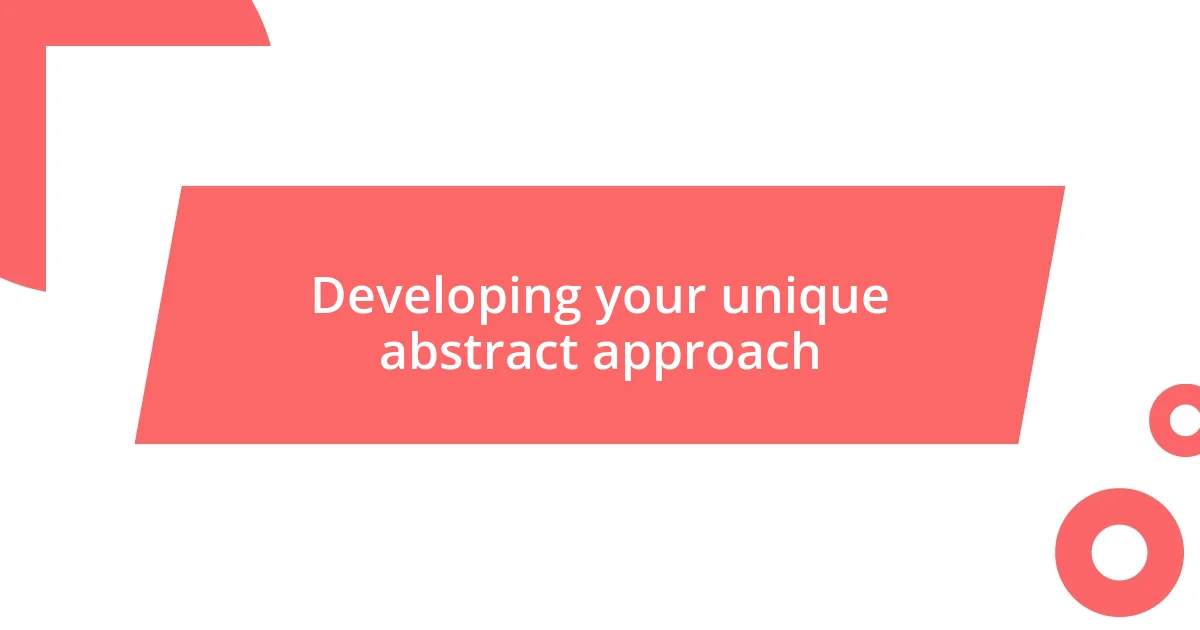
Developing your unique abstract approach
Finding your own unique approach to abstract art is truly a journey worth taking. One day, as I was experimenting with different brush techniques, I realized that the marks I created weren’t just about color—they told a story about my mood that day. Have you ever felt a surge of inspiration from the simplest action? I remember just splattering paint onto the canvas, letting my emotions guide the trajectory of each drop. Suddenly, the canvas transformed from a blank space into a reflection of my soul.
As I tried incorporating various elements like collage or mixed media, I found joy in the juxtaposition of materials. During one particularly spontaneous session, I used newspaper clippings alongside vibrant acrylics, and it clicked for me. It was a theatrical performance of sorts, where every element fought for attention yet harmoniously blended together. What if your next creation felt like a conversation between different layers of who you are? I believe that this layering can reveal unexpected insights about our lives and experiences.
Embracing the chaos of creation often leads to personal breakthroughs. I vividly recall a moment when I stepped back from a busy, layered canvas and felt an undercurrent of clarity wash over me. Every color, every texture had a reason, a purpose deeply rooted in my emotions. I began to understand that developing a unique abstract approach isn’t just about the final product—it’s about the journey and self-discovery along the way. What parts of yourself might you uncover through the brushstroke?
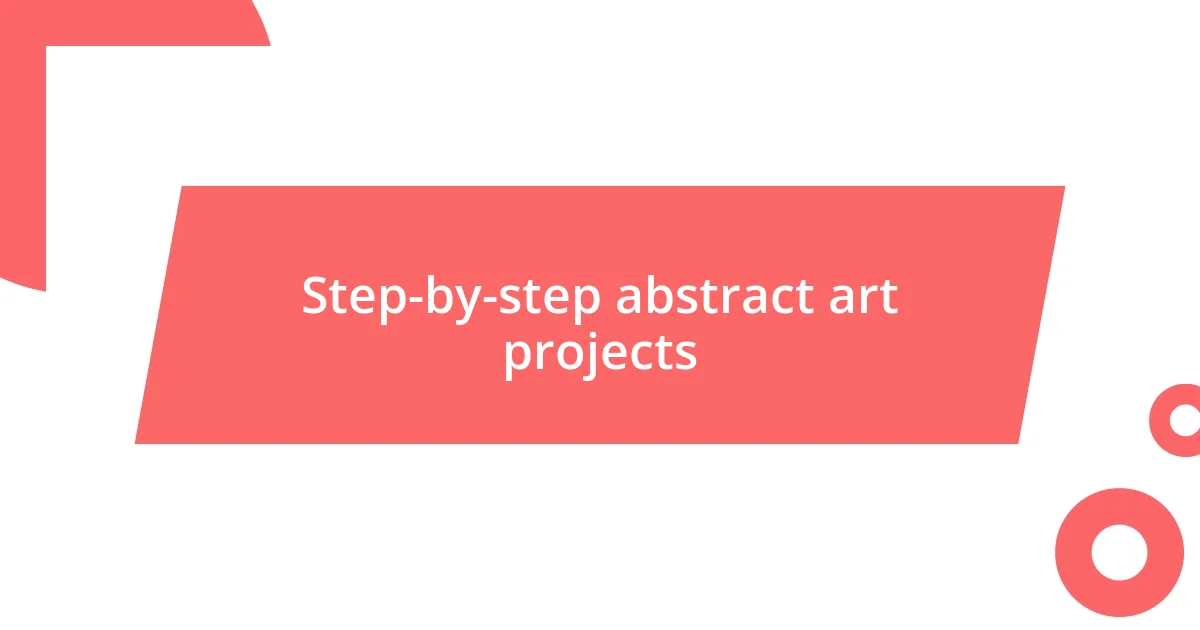
Step-by-step abstract art projects
Creating abstract art can be a thrilling adventure, and I found that stepping through specific projects helps streamline the creative process. For instance, one day, I decided to embark on a color exploration project. I gathered a trio of contrasting colors and simply began smearing them across the canvas, letting the hues interact naturally. The excitement of seeing how each color responded to the others reminded me of a vibrant conversation. Can you feel the energy shift when colors mingle unexpectedly?
In another project, I chose to work with texture. By layering different materials—think sand, fabric scraps, and even some dried leaves—I crafted a mixed-media canvas that surprised me with its depth. The tactile quality of the surfaces evoked feelings of nostalgia and warmth. Have you ever touched a piece of art and felt a direct connection with it? I believe that incorporating varied textures invites the viewer to engage more intensely with the piece, sparking an emotional dialogue.
As I experimented with a spontaneous drip painting technique, I learned to embrace unpredictability. I set the canvas flat, then poured paint directly from the bottle, watching it cascade in unexpected patterns. It was exhilarating, and I felt almost like a conductor leading an orchestra of colors. This moment taught me the beauty of letting go and trusting the process. So, what could you discover if you allowed your intuition to guide your brush? Each project has been a step in understanding not just the art, but also the artist within me.
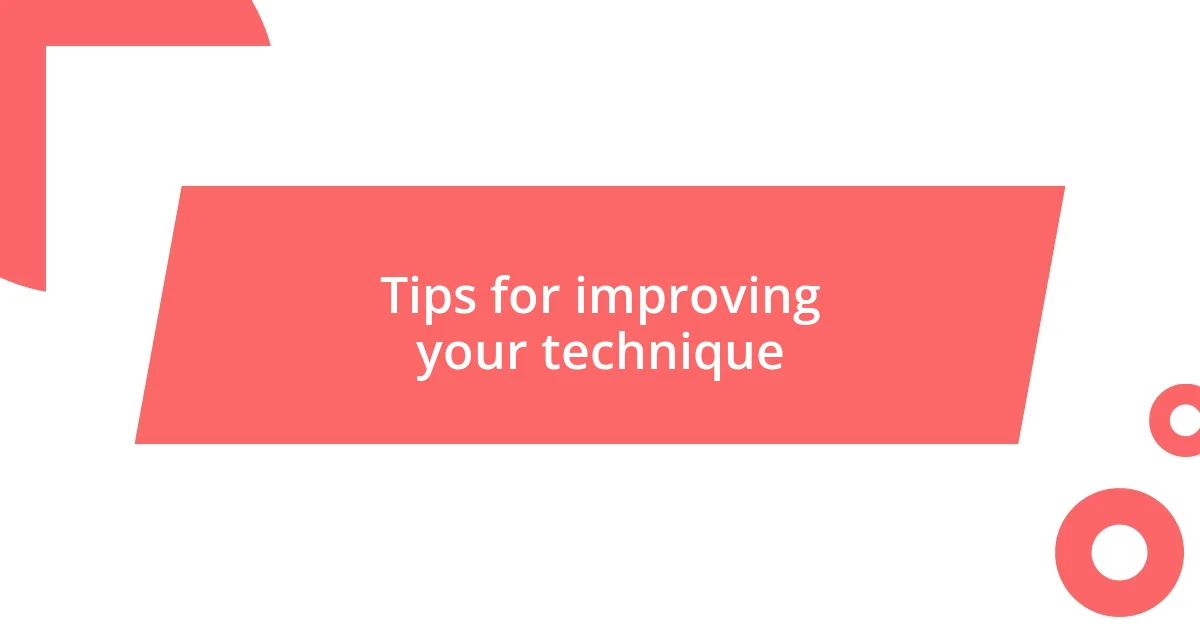
Tips for improving your technique
One effective tip for improving your abstract art technique revolves around the concept of setting boundaries. I remember a session where I deliberately restricted myself to only using blue and yellow. Limiting my palette pushed me to explore the emotional depth within those colors and how they intermixed. Have you ever noticed how constraints can spark creativity? It made me realize that embracing limitations often opens avenues to innovation.
Another valuable aspect is to frequently reassess your work. There was a time I completed a canvas, feeling it was perfect, only to revisit it days later and feel it was lacking life. Stepping away helped me gain perspective. When you look back, what feelings do you want to evoke in your audience? I learned that taking breaks and revisiting my art with fresh eyes can lead to deeper insights and improvements I hadn’t initially perceived.
Lastly, always document your process. I started keeping a visual journal of my projects, capturing thoughts, feelings, and techniques used during each session. This practice not only serves as a reflection of my growth but also as a reservoir of inspiration. How often do you take the time to look back at what you’ve created? I find that revisiting past entries fuels my creativity and reminds me of the unique paths I’ve explored as an artist.
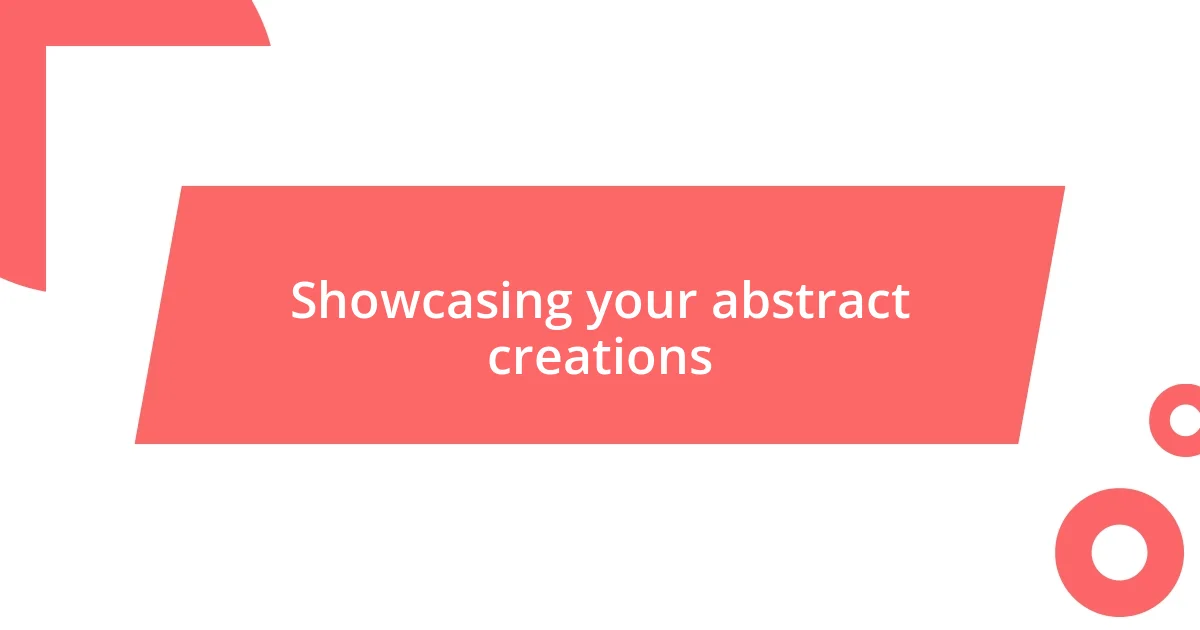
Showcasing your abstract creations
When it comes to showcasing your abstract creations, I’ve discovered that the presentation can deeply influence the viewer’s experience. I remember one particular exhibit where I displayed my work in a dimly lit room, allowing the colors to resonate and breathe. Did you know that lighting can transform a piece? The soft illumination made the vibrant hues appear almost ethereal, inviting viewers to step closer and immerse themselves in the artwork. It felt like a dance between light and color, creating an intimate setting that sparked conversations.
Another powerful technique is utilizing unique display methods. I’ve played with hanging my canvases at varying heights, which encouraged spectators to engage from different angles. It’s fascinating how a simple adjustment can evoke curiosity. Have you ever walked around a piece, only to find aspects you missed at first glance? This spatial exploration opened up a dialogue not just between the art and the viewer, but within myself as I watched people interpret my creations in unexpected ways.
Lastly, social media has become a vital platform for sharing my abstract work. I’ve found that capturing the process creates a connection that resonates with my audience. For example, when I posted a time-lapse of my creative process, the response was overwhelmingly positive. Many people commented on how they felt a part of my journey, and it made me realize the importance of vulnerability in art. Which platforms do you find most effective for sharing your creations? Ultimately, fostering a community around your work can lead to meaningful conversations and inspire others to embark on their own artistic journeys.


